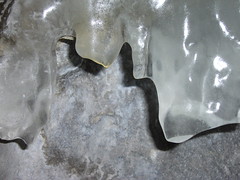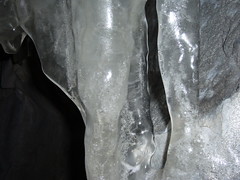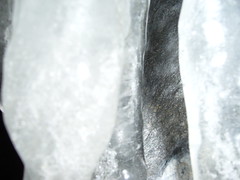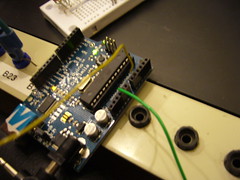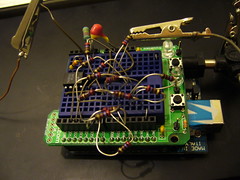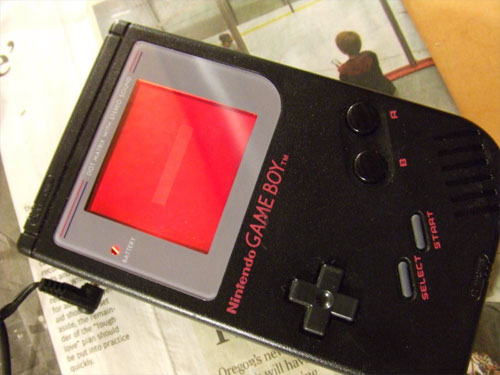Google may harm your computer!
January 31st, 2009
…just as well as every other site. (But now they’ve fixed the error)
Japanese for Nerds
January 15th, 2009Japanese for nerds is new blog by lmm/Patrick. I don’t actually know the guy, but I found his blog through my referrer log because he was linking to my Gameboy Music How-To. And I thought his blog was interesting, even if I haven’t commented it as much as it deserves. (In the beginning there wasn’t even a way to comment on his blog)
Anyway, Japanese for nerds is his new project which he describes like this:
The goal for the blog is to post words or phrases that I had to put time in to looking up or learning how to use because they aren’t commonly used. Or something like that.
Sounds like an interesting concept, and I’ve added it to my RSS reader. Gives a little Kana practice too, in a natural context.
The first lesson, fitting enough, is how to translate nerd. The two options are おたく, otaku or インテリ, interri, obviously derived from the English word intelligent.
Lavos’ Cave v1 (Ambient/drone music piece) + some fail poetry
January 11th, 2009

Here’s the first mixdown of this piece that I’ve dubbed Lavos’ Cave. The name, of course, is an hommage to one of the greatest RPG’s.
It’s an ambient/drone piece that I’ve made by layering several feedback loops. The result is a really moody and organic sound that slowly progresses as you meditate and travel through an imaginary cave.
This is just the first crude version. I will make a final mixdown later where I fix some of the nasty clipping and equalize the tracks a bit to make them stand out a bit more against each other. The clipping is due to the fact that this piece was recorded using feedback paths in analogue gear (except for the reverb which is technically not analogue but mechanical ![]() ) so things went out of hand sometimes.
) so things went out of hand sometimes.
Download: http://www.megaupload.com/?d=0K7HDFSS
And some random thoughts that crossed my mind on my way home the other night. Some kind of failed emo poetry or something.
I could take a picture of the ice
Try to remember the endless perfection
With which it revealed itself.
A splendid crystalline structure, a comples cavity,
Leading to an infinite grid of tunnels.
Just like in my autistic childhood fantasies
Ever so cold, ever so distant, ever so near
The place where I want to rest my mind forever
Exploring new paths, new places
With no one interrupting me
^ That’s something I scribbled down in my notebook when waiting for the bus, too tired, too caffeinated. Fits the mood of the music perfectly.
Studio monitors, M-Audio BX5a
December 25th, 2008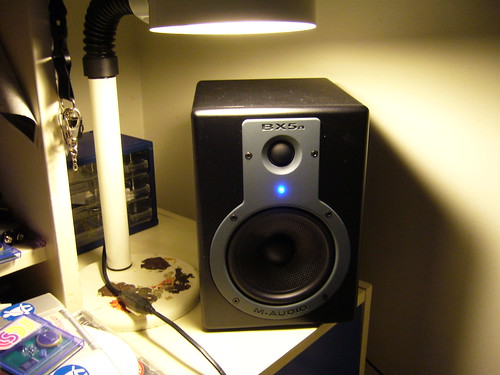
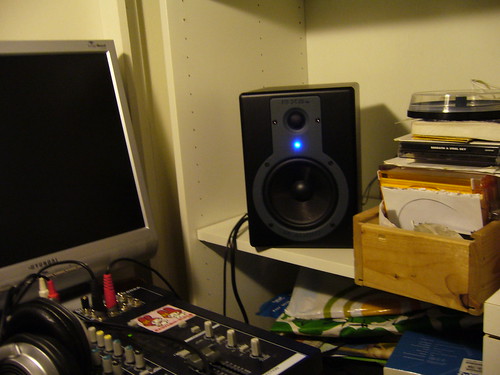
This is my Christmas present for myself, a pair of studio monitors. (That’s music-ish for a pair of reference speakers used to monitor the sound in case you didn’t know ![]() ) They’re a budget model, but I got them for half the price because the store was buying mark II of the same model and had to get rid of the old ones. I didn’t get around unpacking them until pretty late in the night, so I haven’t been able to test them properly yet. (Bass turned down on the mixer, low volume output - don’t want to upset the neighbours) But as far as I can tell they sound ok, absolutely better than anything I owned before. The overall sound image is balanced, but they lack in the sub department. Which is only natural since the job of studio monitors is to be a reference to work by when producing and mastering sound, not to provide a booming bass for listening experience. And they sound good even on low volume levels. They’re also compact, which fits my lifestyle well.
) They’re a budget model, but I got them for half the price because the store was buying mark II of the same model and had to get rid of the old ones. I didn’t get around unpacking them until pretty late in the night, so I haven’t been able to test them properly yet. (Bass turned down on the mixer, low volume output - don’t want to upset the neighbours) But as far as I can tell they sound ok, absolutely better than anything I owned before. The overall sound image is balanced, but they lack in the sub department. Which is only natural since the job of studio monitors is to be a reference to work by when producing and mastering sound, not to provide a booming bass for listening experience. And they sound good even on low volume levels. They’re also compact, which fits my lifestyle well.
So yeah, at any rate I’m satisfied since this is a step up for me.
Perler Bead Christmas Crib
December 25th, 2008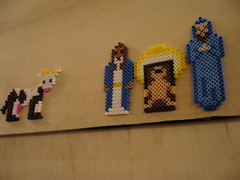
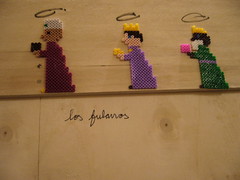



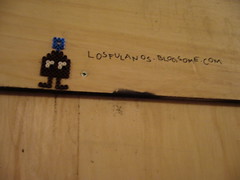
This is the Christmas myth told in Perler Beads. Found in the tunnel under Årstabron, near Tantolunden in Stockholm, Sweden. Apparently made by Los Fulanos.
Perler Beads are getting more popular, and so is pixel art. Coincidence? I think not!
Frankenstein’s Headphones
December 22nd, 2008


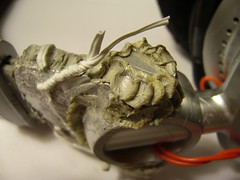
When I originally got these from a friend, they were physically intact, but one wire was broken due to excessive use. So he donated them to me so i could fix them and use them (I didn’t have any decent headphones at the time.) I fixed them by replacing the internal wires with thick, durable copper wires that I placed externally. That’s the orange wires that run into the earpiece.
Everything was fine and dandy for a few months until a crack in the plastic so big that the left earpiece fell off. My first temporary solution was to use tape to keep everything together. It worked, but it wouldn’t sit tight.
Time for the next fix. First I tried super glue which worked at first but soon fell apart. So I proceeded to welding the plastic together with a soldering iron. I also reinforced the plastic with some steel wire. The result is that the plastic is welded into one solid piece, which will hopefully last for a long time.
And it also looks sort of dirty. Since these headphones could’ve died 6 months ago, but I revived them at least twice, I hereby officially dub them “Frankenstein’s Headphones”. After all, the membranes were, and still are working perfectly, so why throw the headphones for something as silly as a broken cable or some cracked plastic?
Tomorrow though, i’ll be getting something better. You’ll see.
PCB Manufacturing at my university (Pictures)
December 19th, 2008So I etched a PCB at my university today, and i thought I’d share some pictures. Today’s PCB is an XR-2206 Based Voltage Controlled Oscillator, a rad oscillator synth module.
The manufacturing process involves several transfers: Paper -> Photographic film -> Photoresist -> Copper. Let’s begin with a picture of three of the steps, the printed paper, the film and the finished PCB.

So the first thing I have to do is print the layout on paper. It needs to be printed with high contrast and dense blackness to transfer well to the photographic film. For this PCB I chose to do the transfer double sized to increase the contrast, but you can transfer it with a 1:1 size source printout. (Or anything between)
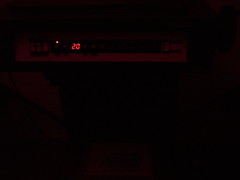
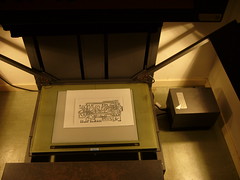
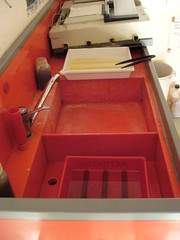 The next step is to expose the photographic film. This is done with a device consisting of a glass plate under which you put the original, and a lid under which you put the film. Both the glass and the lid have vacuum suction to keep the paper and film in place.
The next step is to expose the photographic film. This is done with a device consisting of a glass plate under which you put the original, and a lid under which you put the film. Both the glass and the lid have vacuum suction to keep the paper and film in place.When you press a button, two light sources are turned on to expose the film. The light is reflected against the source material through a lens, and onto the film. The film is, as far as I know standard black and white photographic film. In other words, this device is a giant camera.
The next step is to develop the film. This is done by putting the film first in a “developer” fluid to make the image visible, and then in a “fixer” fluid to protect the film from light. Until the film has been completely developed, the photo room must be lit strictly using a faint red light to avoid exposing the film by accident.
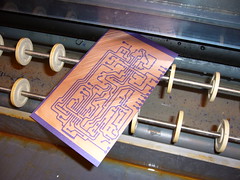

 Next up is transferring the image on the film to the photoresist on the board. Unfortunately I forgot to take a picture of this step, but it’s done by exposing the photoresist to UV light through the film. The photoresist will be weakened in all areas exposed to the UV light. The weakened areas will then be etched away using a CaCO3 (Calcium carbonate) solution in the first etching machine. The result is that the copper is exposed at those parts. (Left picture) And then I put it through the second etching machine, containing iron chloride, which will etch away the exposed copper areas. (Right picture)
Next up is transferring the image on the film to the photoresist on the board. Unfortunately I forgot to take a picture of this step, but it’s done by exposing the photoresist to UV light through the film. The photoresist will be weakened in all areas exposed to the UV light. The weakened areas will then be etched away using a CaCO3 (Calcium carbonate) solution in the first etching machine. The result is that the copper is exposed at those parts. (Left picture) And then I put it through the second etching machine, containing iron chloride, which will etch away the exposed copper areas. (Right picture)

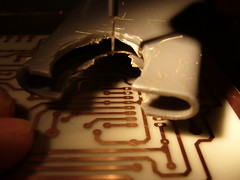
Almost done. The last step is to put the board into a stripper fluid (NaOH, Sodium hydroxide) to remove the remaining photoresist.
After drilling the holes the PCB is ready to be equipped with components.
ModularDuino - An Arduino Based Modular Synthesizer Concept
December 9th, 2008General Description
The idea of using my Arduino for modular synth utilities started out as a crazy idea that I’m now starting to seriously like. The pictures above shows my first design, an oscillator. (I have plans for other modules, see the bottom of this post)
The left picture shows the first prototype where I tried to use PCM to produce the sound. That didn’t sound too good, so I built an 8-bit resistor ladder passive DAC. But I only hade enough of one resistor value, so I used only that value. This gives a non-linear output voltage response. (Distorsion) Additionally I’m only using 6 of the possible 8 bits, further degrading the sound quality. The input voltage response does not conform to any standard (Eg 1V/octave) but has a inversely proportional relationship (f(V)=c*1/V, where V is the voltage, c is some constant and f is the resulting frequency) This relationship is not completely unlike how a Gameboy responds to sound values that you write to it’s sound controller. However, surprisingly enough, it seemed almost impossible to hit musically dissonant intervals, so it seems like I did something right.
I could fix these things, but considering how much I like the itty-gritty lo-fi sound, I doubt that I will.
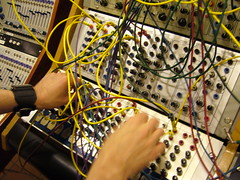
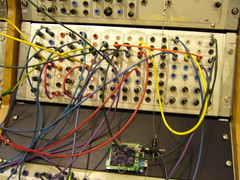
So, me and Veqtor hung out in Studio 6 at EMS, playing around with the Serge interacting with the Arduino. The result is the following sounds:
Sound Samples
Clean/Filtered side by side
This is a short sample to demonstrate what the Arduinoscillator could sound like in a typical modular setup.
Right channel: Clean
Left channel: Filtered by the Serge multimode filter, in LP mode, using an envelope. Various parameters are controlled by the Serge sequencer, and the seuencer is triggered randomly.
Arduinoscillator Glitch Mode

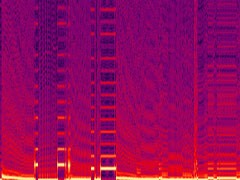
This sample demonstrates how the Arduinoscillator sounds when modulated by the Serge precision VCO, itself and the 50 Hz ground loop that it picked up from my finger. (Hehe)
It gives a pretty good idea of the waveform that this thing outputs.
Funky Arduino Acid
This is the result of my and Veqtor’s session at EMS, where we built a patch that controls the Arduinoscillator with the Serge analogue sequencer, a bit of Serge filter on that, some Serge generated drums. You get the idea.
Even though the oscillator waveform is a sine, it has some pretty smooth digital overtones, that together with the frequency response is perfect for funky acid, as this sample demonstrates.
Future ModularDuino plans
ModularDuino is so far just a concept, more than a truly useful product. The Arduino with it’s accessible design and relatively affordable price, has the potential of becoming a cheap lo-fi component for modular synthesizer users. Some people think that lo-fi sound and digital artefacts is only something bad. Whereas I think it has a place and can be really useful for producing certain sounds.
Anyway, here’s the roadmap for the project.
- Implement real 1 V/Octave frequency response for the Arduinoscillator. (Or keep it this way, hehe)
- Implement φM (Phase angle modulation. When most people FM, they means this) This can be done, but probably requires me to learn more about the Atmega168 controller on the Arduino and write some assembly code. Bricks will be shat.
- More waveforms can be added relatively easily.
- I’m also planning a delay module. The Arduino has the potential to store a buffer of about a second in RAM, which could be used to create a lo-fi 8-bit delay comparable to BBD delays.
- It’s pretty possible to make waveshapers or distorsion units with a characteristic digital sound.
- Envelopes, LFOs and perhaps sequencers with extended possibilities, editable code and a lo-fi touch.
- This is just a little dream of mine, but I would guess it’s not completely impossible to create a filter using the arduino. The most CPU intense part of most filter algorhithms is usually the resonance, so my idea is to solve that with an external feedback loop, while the Arduino emulates a 1-pole filter.
The last module might not be worth it, but the others can be achieved pretty easily, so check back regularly. I’m planning to release the code and schematics under a Creative Commons license at some point, but right now the code is a mess and the schematics only exist as prototypes on a breadboard, so bear with me.
I’d Also like to give a shout out to the crazy Aussie Sebastian Tomczak who’s a Gameboy fetishist and Arduino wiz. A little bird whispered in my ear that he’s planning yet another audio-related Arduino project. I’ll be waiting eagerly. ![]()
Pro Backlight for Gameboy (Highly delicious!)
December 2nd, 2008
Words can hardly describe how delicious these pictures are. The red one looks like a lava pond and blue one… so clean and so solid. I’m just trying to imagine how these would look IRL, which is giving me goosebumps. This mod by Nonfinite comes in several colors (See more pictures here) and it’s presumably made using ultra bright LEDs, bat wings and a mushroom from Lost Woods.
There will be DIY kits and modded units for sale at Blipfest, so be there.
![You suck at protoshop. No, you [i]really[/i] oo.](http://blog.gg8.se/images/you-suck-at-photoshop-you-really-do-your-awful.png)





